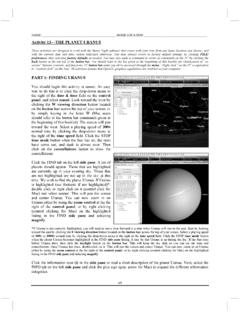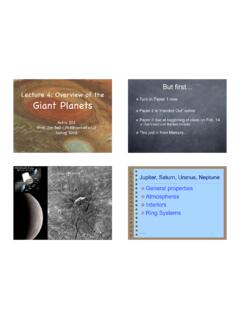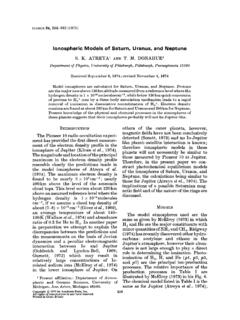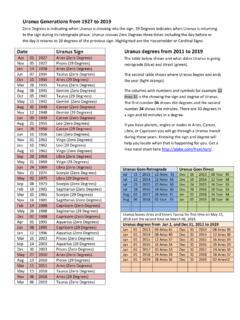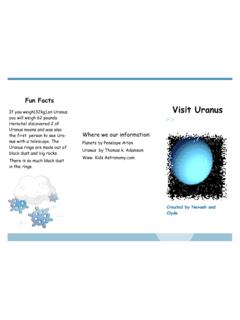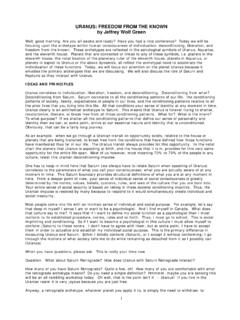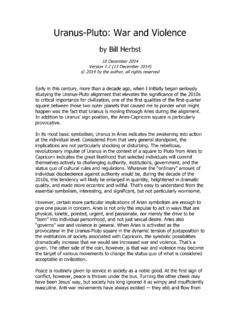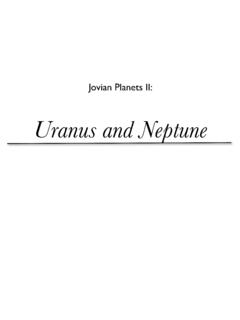Transcription of Astronomy for Kids - Uranus
1 Astronomy for kids - UranusA Seemingly Featureless PlanetUranus, along with Neptune and Pluto, is in the most distant region of our solarsystem. The giant planet, which is another of the gas giants of our solar system,is more than twice as far away from the Sun as Saturn. If you get a chance tolook at Uranus through a telescope, all you will see is a faint blue disk thatappears exceptionally dull and lifeless. Even pictures sent back by the Voyagermission and the Hubble Space Telescope seem to show that Uranus is a dull,unexciting always, though, things aren't what they seem.
2 Uranus has many interestingfeatures, including its ring system, varied moons and much more. The blandface that the planet shows to us humans hides high speed winds, the fact thatUranus is tilted on its side and a very mysterious weather system. Read on tofind out more about this mysterious world! Uranus FactsDistance from SunApproximately billionmilesNumber of MoonsAt least 21 DiameterApproximately 32,000milesLength of Day17 Earth hoursLength of Year84 Earth yearsNameAncient Greek byVoyager 2A Pale Blue-Green DiscAlthough the Voyager spacecraft visited the seventh planet during its epicjourney through our solar system, the pictures it sent back from Uranus weresomewhat disappointing.
3 We had hoped to see some color bands like there areon Jupiter or at least some faint colors, but the face the planet presents doesn'tseem to vary, regardless of how close or far away from it you , unlike Jupiter or Saturn, does not seem to have a solid core of anykind. The planet does contain some rocky material, but the planet is almost allgas, with the outer layer of methane providing the blue color we see in thepicture at the pale blue image we see of Uranus hides the fact that the surface of theplanet is swept by "winds" moving along at several hundred miles per were able to detemine this by carefully studying the images thatVoyager sent from VoyagerA pictureof Uranus takenby the Voyager World on TiltWhen Voyager arrived at Uranus .
4 It discovered a number of moons that wereunknown to us. In addition, we found out that the planet is tilted on its side! Allthe other planets in our solar system pretty much have their equator lined updirectly with the Sun. Uranus 's equator is tilted at almost right angles to the Sun,which gives the planet very unusual seasons and gives us a different view ofthe planet depending on when we look at it. This proves once again that thingsare hardly ever as they seem on the on the link at right to find out more about the planet's tilt and what effects Tilted WorldClickhereto learn moreabout the tilt of Content Copyright 2003 Astronomy for KidsPermission is granted for reproduction for non-commercial educational for kids - UranusA Wide Variety of Very Unusual MoonsBefore the Voyager mission arrived at Uranus , we knew that Uranus had fivemoons.
5 But we didn't really know much about them because of the planet'sgreat distance from the Sun. What a surprise we had waiting for us!Not only did Voyager show us that there were eleven more moons orbiting thegiant planet, it also revealed that the moons were very interesting in their was a moon with cliffs on it higher than Mount Everest here on Earth, onewith one very smooth side and one very rough side and much, much on the link at right to find out more about the some of the fascinatingmoons of Moons of UranusClickhereto learn moreabout the moons of Out More About UranusUranus Page at the Nine Planets SiteThe Uranus section of the Nine Planets site has more detail about this mysterious Voyager MissionThe Voyager mission sent back almost all of the pictures of Uranus that we have used in this Content Copyright 2003 Astronomy for KidsPermission is granted for reproduction for non-commercial educational for kids - Uranus
6 From Voyager 2 Uranus from Voyager 2 Image courtesy of: NASA, Voyager 2 MissionDuring its epic journey through our solar system, the Voyager 2 spacecraft sent back this image of Uranus . Theplain, blue image you see here disguises all the interesting things we have learned about the Content Copyright 2003 Astronomy for KidsPermission is granted for reproduction for non-commercial educational for kids - A World on TiltUranus's Tilt in 1998We have seasons here on Earth because ourplanet is tilted on its axis. As our planet makes itsway around the Sun, the tilt of Earth means thatdifferent amounts of our planet receive more directsunlight than others.
7 When the northernhemisphere of Earth is tilted towards the Sun, ithas summer and the southern hemisphere haswinter. Six months later, the weather is also has "seasons", but the extreme tilt ofthe planet makes the seasons vary widely. Thehigh degree of tilt also gives us a much differentview of the planet depending on when we see itduring its eighty-four year long trip around the Voyager arrived at Uranus in 1986, theplanet's pole was facing the sun. In 1998, theHubble Space Telescope took this picture ofUranus and its rings and the tilt has from HubbleImage courtesy of: Hubble Space TelescopeUranus's Tilt in 2002In December of 2002, the European SouthernObservatory took this amazing picture along withsix of the giant planet's moons.
8 Not only is this anexcellent picture of the planet, along with its ringsand several of its moons, it also shows that in arelatively short period of time, the tilt of the planetseems to have , the tilt of the planet has not changed, butits position relative to Earth and the Sun haschanged, so we see a very different view than wehad just a few short years in 2002 Image courtesy of: European Southern ObservatoryOriginal Content Copyright 2003 Astronomy for KidsPermission is granted for reproduction for non-commercial educational for kids - The Moons of UranusThe Five Largest Moons of UranusImage courtesy of: NASA-Voyager missionCurrently, we know that Uranus has at least twenty-one moons.
9 The above image is a "family portrait"of the five largest moons of the planet. From left to right, they are Miranda, Ariel, Umbriel, Titania andOberon. The Voyager mission discovered ten more moons when it visited the planet in 1986 andsince then, astronomers have discovered six it is the smallest of the five larger moons of Uranus ,Miranda nonetheless has presented us with a number of puzzles. Ifyou look closely at the picture at the right, you will notice that abouthalf of the moon looks like a lot of the other moons in our solarsystem.
10 It has lots of craters that tell us that it has been hit by manyobjects during its long other half of the moon is covered by what appear to be giantcliffs, grooves, gullies and other features a lot like you might find inthe American West, although much, much larger. What has causedall of these unusual features? In all honesty, nobody really knows,and the only we will find out is to send another spacecraft to thedistant planet for an extended courtesy of: NASA - Voyager missionThe half of Miranda that is covered with canyons, valleys and giant ridges isthe most interesting part of this tiny world.
